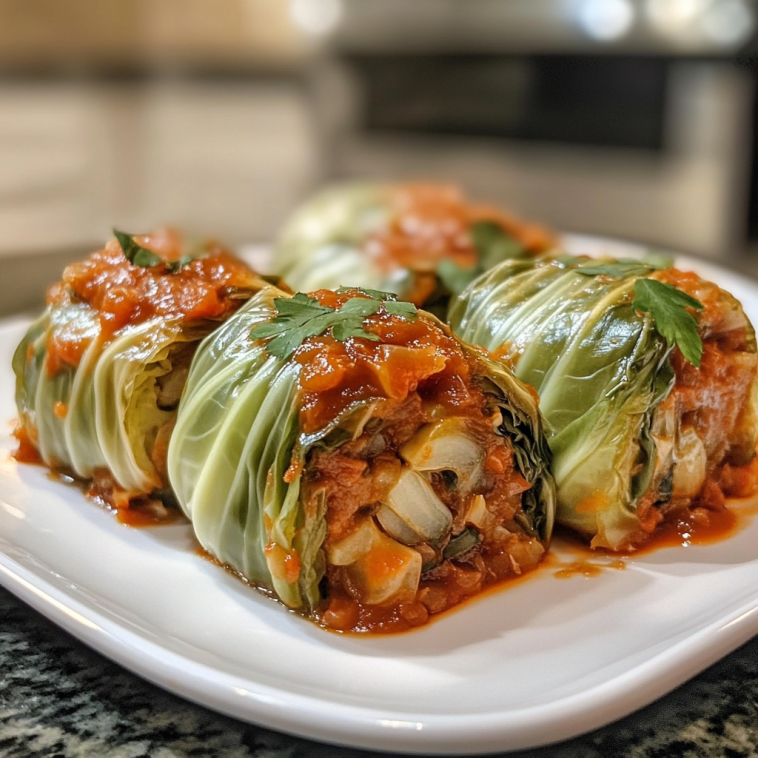Stuffed cabbage rolls, also known as golubtsi (in Slavic countries), sarma (in the Balkans and Turkey), or simply cabbage rolls, have been a cherished dish for centuries. This comforting recipe, passed down through generations, blends tender cabbage leaves with a flavorful filling of seasoned meat and rice, all simmered in a savory tomato sauce. Whether it’s a holiday feast, a family dinner, or a special occasion, classic stuffed cabbage rolls are a dish that brings warmth and a sense of tradition to any table.
In this article, we’ll delve into the history, ingredients, preparation, and variations of stuffed cabbage rolls. So, let’s take a closer look at this timeless dish and how it has evolved into a favorite comfort food around the world.
The History of Stuffed Cabbage Rolls
The origins of stuffed cabbage rolls can be traced to Eastern Europe, with different cultures adopting variations of the dish and giving it their own unique twist. The practice of stuffing cabbage leaves with a filling likely began in the Middle East or the Mediterranean, where cabbage was plentiful and served as a good base for various fillings. The dish spread across Europe over time, reaching regions like Poland, Ukraine, Russia, the Balkans, and even as far as Scandinavia.
Each region adapted the recipe to its local tastes and available ingredients. The name “golubtsi” in Ukraine and Russia refers to a dish made of cabbage leaves filled with meat and rice, while the Balkan and Turkish variations, called sarma, are often made with ground lamb or pork. In some cases, vegetarian versions with rice, mushrooms, or beans were developed as well.
Though variations exist, the common thread is that stuffed cabbage rolls are designed to be hearty, satisfying, and affordable—a perfect comfort food that has endured through history.
Key Ingredients for Classic Stuffed Cabbage Rolls
The ingredients for stuffed cabbage rolls are simple yet versatile, making it easy to customize the dish based on personal preferences and what you have available in your pantry. The basic ingredients typically include the following:
Cabbage – The star of the dish, cabbage leaves are blanched to soften and make them pliable. Regular green cabbage is typically used, but some recipes might call for savoy cabbage, which has a more tender texture and delicate flavor.
Ground Meat – The most common choice is ground beef, though some recipes call for a combination of ground beef and pork for added flavor. Ground turkey or chicken can also be used for a lighter version.
Rice – Long-grain white rice is typically mixed with the meat, helping to stretch the filling and add texture. Brown rice can be substituted for a healthier alternative, and some recipes might even call for barley or quinoa.
Herbs and Seasonings – Onion, garlic, salt, pepper, and paprika are classic seasonings. Fresh dill is often added for an extra layer of flavor, especially in Eastern European variations. Bay leaves and thyme are common additions to the sauce, which infuses the rolls with aromatic flavors.
Tomato Sauce – The cabbage rolls are typically simmered in a tomato-based sauce, which adds moisture and a savory depth to the dish. Some recipes call for crushed tomatoes, while others may use tomato paste, diced tomatoes, or even sauerkraut for a tangier flavor.
Stock or Broth – For extra flavor, beef or vegetable stock is often used to help cook the cabbage rolls and create a rich sauce.
Acidic Elements – A touch of acidity, such as lemon juice or vinegar, can balance the richness of the meat filling and provide a bright contrast to the savory tomato sauce.
Preparation: Step-by-Step Guide to Making Classic Stuffed Cabbage Rolls
Making stuffed cabbage rolls might seem daunting at first, but the process is straightforward once you break it down into manageable steps. Here’s a simple guide on how to prepare this delicious dish:
Step 1: Preparing the Cabbage Leaves
Start by preparing the cabbage. Cut the core out of a large head of cabbage and carefully separate the leaves. You will need about 12–16 large leaves, depending on how big your cabbage is and how many rolls you plan to make. To soften the leaves, blanch them in a pot of boiling water for a few minutes until they are pliable. Use tongs to remove the leaves and set them aside to cool. Alternatively, you can freeze the cabbage for a day, and when thawed, the leaves will separate easily without the need for boiling.
Step 2: Making the Filling
While the cabbage is cooling, prepare the filling. In a large bowl, combine the ground meat, cooked rice (you can use leftover rice if you have some on hand), finely chopped onions, minced garlic, paprika, salt, and pepper. If you like, you can also add some fresh dill or thyme for extra flavor. Mix everything together until evenly incorporated. If the mixture feels too dry, you can add a small splash of beef broth or water to help bind it together.
Step 3: Assembling the Cabbage Rolls
Once the cabbage leaves are cool enough to handle, cut off any thick veins that run down the center of the leaves. This will help the leaves roll up more easily. Lay each cabbage leaf flat, and spoon a portion of the meat mixture into the center. Fold the sides of the leaf over the filling and then roll it tightly from the bottom to the top. Repeat this process for each cabbage leaf, making sure to tightly pack the rolls to prevent the filling from escaping during cooking.
Step 4: Simmering in Tomato Sauce
In a large pot or Dutch oven, pour a layer of tomato sauce on the bottom. Arrange the stuffed cabbage rolls in the pot, packing them snugly next to each other. Pour the remaining tomato sauce over the rolls, adding enough to cover them. You can also add some beef or vegetable broth, along with bay leaves, thyme, and a dash of vinegar or lemon juice for extra depth.
Bring the pot to a simmer over medium heat. Once it starts to bubble, reduce the heat to low, cover, and let the cabbage rolls cook for 1.5 to 2 hours. The slow cooking process allows the flavors to meld together and ensures that the cabbage is tender and the filling is cooked through.
Step 5: Serving the Cabbage Rolls



